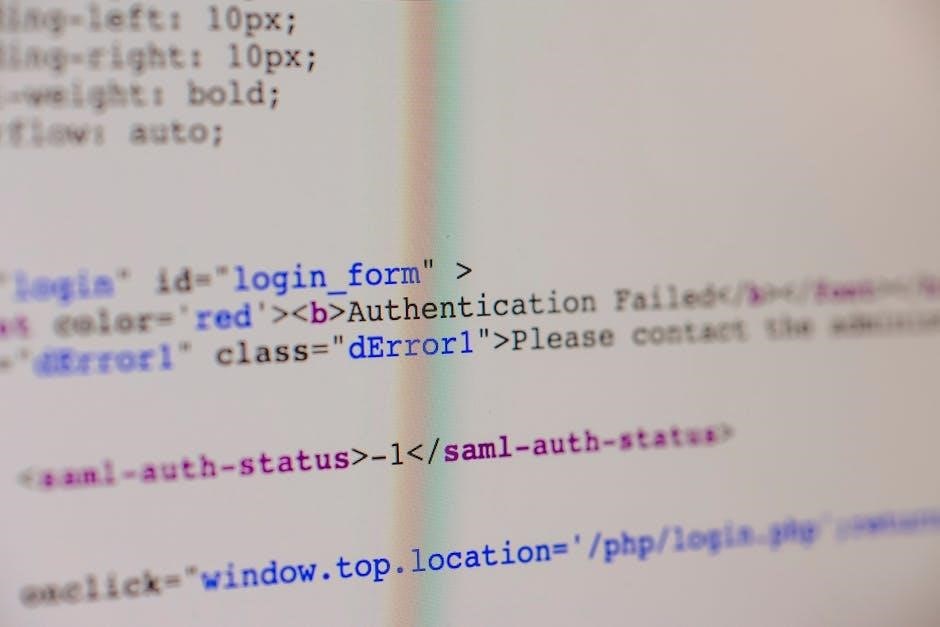
Form 8867 is a checklist used by paid tax preparers to ensure due diligence when claiming tax credits like EITC, ACTC, or Head of Household status. It verifies eligibility and compliance with IRS requirements, ensuring accurate claims and avoiding penalties. This form must be submitted with the tax return, either electronically or on paper, and proper documentation must be retained for at least three years for audit purposes.
1.1 What is Form 8867?
Form 8867, titled Preparer’s Due Diligence Checklist, is an Internal Revenue Service (IRS) form used by paid tax preparers to verify eligibility for certain tax credits. It ensures compliance with due diligence requirements when preparing returns that claim credits like the Earned Income Tax Credit (EITC), Child Tax Credit (CTC), or the Additional Child Tax Credit (ACTC). The form requires preparers to document steps taken to confirm a taxpayer’s eligibility, including verifying income, family relationships, and residency. It helps prevent errors and fraud by ensuring accurate claims. Preparers must complete this form for each applicable return and retain it for records, as the IRS may audit to ensure proper adherence to guidelines.
1.2 Importance of Form 8867
Form 8867 plays a critical role in ensuring compliance with IRS regulations and maintaining the integrity of tax credit programs. By requiring paid preparers to conduct thorough due diligence, it helps prevent errors and fraudulent claims, protecting both taxpayers and the government. The form ensures that eligibility criteria for credits like the EITC, CTC, and ACTC are met accurately, reducing the risk of audits and penalties. It also promotes transparency and accountability in tax preparation, safeguarding the credibility of the tax system. Proper use of Form 8867 demonstrates a preparer’s commitment to ethical practices and adherence to legal standards, ultimately benefiting both clients and the IRS by fostering trust and accuracy in tax filings.

Purpose and Scope of Form 8867
Form 8867 ensures accurate eligibility verification for tax credits, covering EITC, CTC, and others. It standardizes due diligence processes, ensuring compliance with IRS requirements and reducing errors.
2.1 Purpose of Form 8867
Form 8867 is designed to ensure paid preparers verify clients’ eligibility for certain tax credits accurately. It helps prevent errors and fraud by standardizing the verification process. The form is used to document due diligence for credits like the Earned Income Tax Credit (EITC) and the Child Tax Credit (CTC). By requiring preparers to follow specific procedures, it ensures compliance with IRS guidelines. This process helps maintain the integrity of the tax system by ensuring only eligible individuals receive these credits. Preparers must complete Form 8867 for each qualifying credit claimed, providing a clear audit trail. The form also aids the IRS in identifying non-compliant preparers and maintaining program integrity.
2;2 Scope of Credits Covered by Form 8867
Form 8867 applies to specific refundable tax credits, primarily the Earned Income Tax Credit (EITC), the Child Tax Credit (CTC), and the Additional Child Tax Credit (ACTC). These credits are subject to due diligence requirements because they are refundable, meaning taxpayers can receive a refund even if the credit exceeds their tax liability. The form ensures paid preparers verify eligibility for these credits, reducing improper payments. It covers credits where income, family relationships, and residency are critical factors. By focusing on these credits, Form 8867 helps maintain the integrity of the tax system and prevents fraud. Paid preparers must use this form to document their verification processes for these specific credits, ensuring compliance with IRS regulations and accurate reporting.

Due Diligence Requirements for Paid Preparers
Paid preparers must verify eligibility for tax credits by reviewing income, family relationships, and residency to ensure accurate claims and compliance with IRS regulations.
3.1 Overview of Due Diligence Requirements
The due diligence requirements for paid preparers ensure accurate eligibility determinations for tax credits. These requirements mandate that preparers verify documentation, understand legal standards, and ensure claims align with IRS guidelines. Preparers must review income, family relationships, and residency to confirm eligibility. Additionally, they must document their verification process and maintain records for audit purposes. Failure to meet these standards can result in penalties. The goal is to prevent errors and fraudulent claims while ensuring compliance with tax laws. Preparers must stay informed about updates to credit requirements and apply consistent verification methods. Thorough record-keeping is essential to support the preparation process and demonstrate compliance with due diligence obligations.
3.2 Steps to Meet Due Diligence Requirements
To meet due diligence requirements, paid preparers must follow specific steps. First, verify the taxpayer’s identity, income, and eligibility for credits using documentation like W-2s, 1099s, and Social Security cards. Conduct a thorough interview to gather accurate information about family relationships, residency, and other relevant details. Document all responses and ensure the taxpayer understands the questions. Next, review IRS guidelines to confirm eligibility for credits like the EITC or Child Tax Credit. Accurately complete Form 8867, ensuring all information aligns with the documentation provided. Maintain detailed records of the verification process, including notes from interviews and copies of documents. Finally, review the completed form for accuracy before submission to avoid errors or omissions.

Completing Form 8867
Ensure accuracy by gathering necessary documents, verifying eligibility, conducting interviews, documenting responses, and performing calculations. Follow IRS guidelines to complete each section thoroughly and submit correctly.
4.1 Gathering Necessary Documents
To complete Form 8867 accurately, gather all required documents, including photo ID, Social Security cards or ITINs, birth certificates for dependents, and W-2/1099 forms. Collect records of earned income, such as pay stubs, and any documents supporting education expenses or other credits. Ensure you have proof of filing status, like divorce decrees or marriage certificates, if applicable. Additionally, gather receipts for childcare payments and any relevant tax-related correspondence. Organize these documents to streamline the form completion process and ensure no essential information is missing; Verify the authenticity and completeness of each document to avoid delays or errors. Follow IRS guidelines for acceptable documentation to meet compliance standards. Proper organization ensures accuracy and efficiency when preparing the form. Always cross-verify documents with the taxpayer’s information for consistency.
4.2 Determining Eligibility Criteria
To determine eligibility for the Earned Income Tax Credit (EITC) using Form 8867, ensure the taxpayer meets specific requirements. First, verify their income level, which must be below the thresholds set by the IRS, varying based on filing status and the number of qualifying children. The taxpayer must have earned income from a job or self-employment. They must also meet the age requirement, typically being at least 19 years old, or qualify under exceptions for those 18 or older. Additionally, the taxpayer must be a U.S. citizen or resident alien for the entire tax year. A qualifying child must meet the relationship test, live with the taxpayer for more than six months, and be under 19 years old, a full-time student under 24, or permanently disabled. Finally, investment income must not exceed the specified limit. These criteria ensure the credit is appropriately targeted.
4.3 Conducting the Taxpayer Interview
Conducting a taxpayer interview is crucial to accurately complete Form 8867. Begin by preparing a list of questions to gather necessary information about income, family members, and living situation. Ask about employment details, such as job titles, employers, and earnings, to verify earned income. Inquire about the taxpayer’s filing status, dependents, and their relationship to the taxpayer. Discuss residency and housing details to confirm eligibility. Ensure questions are clear and concise to avoid confusion. Verify responses by cross-referencing with documents like W-2s or 1099s. Maintain a professional and respectful tone to build trust. Document all responses accurately, as they will be used to complete the form. This step ensures compliance with IRS requirements and helps prevent errors or omissions. Proper documentation supports the taxpayer’s eligibility for the EITC.
4.4 Documenting Taxpayer Responses
Accurate documentation of taxpayer responses is essential for completing Form 8867. Record all information gathered during the interview, including details about income, household members, and residency. Use clear and concise notes to capture responses verbatim or summarize them accurately. Ensure all documentation is dated and signed by the taxpayer or preparer. Maintain records of any calculations or assumptions made based on the taxpayer’s statements. Store these documents securely, either physically or electronically, to protect sensitive information. Proper documentation ensures compliance with IRS requirements and provides a clear audit trail. It also helps resolve potential disputes or questions during an audit. Retain these records for at least three years, as required by IRS guidelines, to ensure accessibility if needed. This step is critical for maintaining integrity and transparency in the preparation process.

Submitting Form 8867
Form 8867 must be submitted electronically via the Modernized e-File system or by mailing to the specified IRS address. Ensure accuracy to avoid delays.
5.1 Electronic Submission Requirements
Form 8867 must be electronically submitted through the IRS Modernized e-File (MeF) system. Tax preparers must use software certified by the IRS for this purpose. Ensure all data entry fields are accurately completed, as incomplete submissions will be rejected. Registrations for e-filing must be up-to-date, and secure connections are required to protect taxpayer information. Acknowledgments of submission will be provided electronically upon successful filing. Double-check all entries before submission, as corrections post-submission may delay processing. Deadline adherence is critical; late submissions may result in penalties. Always retain a copy of the confirmation acknowledgment for records. Electronic submission is the preferred method for faster processing and reduced errors.
5.2 Paper Submission Guidelines
When submitting Form 8867 by paper, ensure the form is completed accurately and signed. Mail the original form to the IRS address listed in the instructions. Use a legible font or black ink to avoid rejection. Include all required attachments and documentation. Staple multiple pages securely to prevent separation. Do not use binders, folders, or covers. Use a traceable mailing method for proof of delivery. Retain a copy for your records. Address the envelope correctly, using the appropriate IRS mailing address for your location. Avoid using photocopies of the form, as only original forms are accepted. submissions must be postmarked by the deadline to avoid penalties. Paper submissions may take longer to process compared to electronic filing.
5.3 Retaining Records for Audit Purposes
Retaining accurate and complete records is crucial for audit purposes when filing Form 8867. Maintain copies of the completed form, supporting documentation, and any notes from taxpayer interviews. Keep records for at least three years from the date the form was filed or the credit was claimed. Store documents securely, either physically or electronically, to ensure accessibility. Organize records clearly to facilitate quick retrieval during an audit. Failure to maintain proper documentation may result in penalties or disallowance of credits. Ensure all records are legible and include dates, signatures, and detailed explanations. This documentation demonstrates compliance with due diligence requirements and supports the accuracy of the information reported on Form 8867.

Record Keeping and Documentation
Record keeping is a critical compliance practice for Form 8867. Maintain accurate and complete records to support claims and facilitate audits or reviews.
6.1 Importance of Record Keeping
Proper record keeping is essential for compliance with Form 8867 requirements. Maintaining detailed documentation ensures accuracy and supports claims during audits or reviews. It also helps verify eligibility for credits and demonstrates due diligence. Records provide a clear audit trail, reducing the risk of penalties or disputes. Additionally, they enable efficient retrieval of information for IRS scrutiny. Accurate and organized records are vital for ensuring compliance with regulatory standards. Paid preparers must retain all relevant documents, including taxpayer interviews and eligibility assessments. This practice not only safeguards against errors but also upholds professionalism and accountability in tax preparation services.
6.2 Types of Documents to Maintain
Accurate record keeping for Form 8867 requires maintaining specific types of documents. These include records of taxpayer interviews, such as notes or audio recordings, to confirm eligibility. Additionally, documentation of earned income verification, like pay stubs or W-2 forms, must be retained. Identification records, such as driver’s licenses or Social Security cards, should also be kept on file. Calculations and supporting materials for credit eligibility, including any written explanations, are essential. Furthermore, a record of the due diligence process, including checklists or forms used during the interview, must be preserved. These documents ensure compliance and provide evidence of proper preparation and verification processes.
6.3 Duration for Keeping Records
Records related to Form 8867 must be retained for a minimum of three years from the date the return was filed or the date the credit was claimed, whichever is later. This duration ensures compliance with IRS audit requirements and provides ample time for any potential reviews or disputes. The retention period applies to all documentation, including interviews, verifications, and calculations. Additionally, records should be stored securely, either physically or electronically, to maintain integrity and accessibility. Failure to retain records for the required period may result in penalties or loss of credibility in case of an audit. Proper storage and organization of these documents are essential for efficient retrieval when needed.

Special Considerations
Special considerations for Form 8867 include handling prior year earned income, amended returns, and eligibility changes. These scenarios require careful documentation and IRS guidance adherence to ensure compliance and avoid disputes during audits or reviews.
7.1 Using Prior Year Earned Income
Using prior year earned income on Form 8867 is permitted under specific circumstances, such as when current year income is unavailable. Tax preparers must document the rationale for using prior year data, ensuring it reflects the taxpayer’s current eligibility for credits. The IRS requires that prior year income be accurately represented and relevant to the current tax situation. Preparers must also verify that the use of prior year income does not misrepresent the taxpayer’s eligibility for credits like the EITC or ACTC. Proper documentation, including records of prior year earnings and justification for their use, is essential to avoid audit issues. This step ensures compliance with IRS guidelines while maintaining the integrity of the tax credits claimed.
7.2 Relationship with Other Tax Forms
Form 8867 interacts with several other tax forms to ensure accurate credit calculations. For instance, it relies on income data from Form 1040 and Form W-2 to determine eligibility for credits. Additionally, it integrates with Form 5695 for residential energy credits and Form 8864 for the low-income housing credit. Preparers must ensure data consistency across these forms to avoid discrepancies. Form 8867 also cross-references Form 1040, Schedule 3 for certain non-refundable credits. Accurate transfer of information from these forms is critical to maintain compliance and prevent errors. Proper integration ensures that all applicable credits are calculated correctly and reported on the taxpayer’s return, streamlining the filing process and reducing the risk of audits or delays.

Avoiding Common Mistakes
Avoiding errors in Form 8867 requires attention to detail. Common mistakes include miscalculating credits, incorrect eligibility assessments, and incomplete documentation. Ensure accurate calculations and proper documentation to prevent delays or audits.
8.1 Best Practices for Accuracy
To ensure accuracy when completing Form 8867, implement best practices such as thorough taxpayer interviews, verifying all provided information, and maintaining detailed records. Conduct due diligence systematically, cross-checking data with documentation like W-2s, 1099s, and Social Security cards. Regularly update your knowledge of IRS guidelines to align with current requirements. Utilize IRS resources and tools to enhance understanding and compliance. Document every step of the process, including notes from interviews and supporting documents, to facilitate audits and ensure transparency. Finally, review completed forms before submission to identify and correct errors, ensuring adherence to IRS standards and minimizing the risk of discrepancies.
8.2 Consequences of Non-Compliance
Non-compliance with Form 8867 requirements can lead to significant penalties, including fines and potential loss of preparer privileges. The IRS imposes penalties under Section 6695 of the Internal Revenue Code for failure to meet due diligence requirements, with fines ranging from $500 to $1,000 per violation. Repeated non-compliance may result in enhanced penalties or even disbarment from preparing tax returns. Additionally, preparers may face reputational damage, as non-compliance reflects poorly on their professional integrity; It is critical to understand and adhere to all requirements to avoid these consequences and ensure compliance with IRS standards. Proper documentation and thorough due diligence are essential to mitigate these risks and maintain trust with clients and regulatory authorities.

Frequently Asked Questions
This section addresses common inquiries about Form 8867, covering eligibility criteria, required documentation, submission methods, and deadline guidelines to ensure accurate and timely compliance with IRS requirements.
9.1 General FAQs About Form 8867
Form 8867 is used to claim certain tax credits, including the Earned Income Tax Credit (EITC), Child Tax Credit (CTC), and the Additional Child Tax Credit (ACTC). Eligibility depends on income, filing status, and household composition. The IRS requires accurate documentation, such as Social Security numbers and income statements, to verify claims. Taxpayers must submit Form 8867 electronically or by mail, adhering to specific deadlines. The form helps ensure compliance with tax laws and prevents overpayments. Common questions include eligibility criteria, required documents, and submission methods. Understanding these FAQs ensures accurate filing and avoids delays or penalties; Proper completion of Form 8867 is essential for receiving eligible credits.
9.2 Scenario-Based FAQs
Scenario 1: A taxpayer with a qualifying child claims the EITC but lacks proper documentation. The IRS may deny the credit until valid proof is provided. Scenario 2: A married couple filing jointly discovers an error in their income reporting after submitting Form 8867. They must file an amended return (Form 1040-X) to correct the mistake. Scenario 3: A taxpayer’s filing status changes during the tax year. They must determine their eligibility based on their status at the end of the year. Scenario 4: A non-custodial parent claims the CTC without proper authorization. The IRS will deny the claim if Form 8832 (if required) is not submitted. These scenarios highlight common issues and their resolutions. Always verify eligibility and documentation to avoid delays or penalties. Consulting a tax professional can help navigate complex situations.

Troubleshooting and Additional Resources
Troubleshoot common Form 8867 issues by verifying data accuracy and ensuring compliance with IRS guidelines. For additional support, visit the IRS website or consult a tax professional.
10.1 Resolving Common Issues
Common issues with Form 8867 often involve incomplete or inaccurate information. Ensure all fields are filled correctly and eligibility criteria are met. Verify taxpayer responses and documentation for consistency. If errors are detected, correct them promptly and resubmit the form. For technical difficulties during electronic submission, refer to IRS guidelines or contact support. Maintain clear records of all communications and corrections for audit purposes. Regularly update knowledge on IRS changes to avoid recurring problems. Consulting IRS resources or tax professionals can also help resolve complex issues efficiently. Proper attention to detail and adherence to instructions minimize the risk of errors and ensure compliance with IRS requirements.
10.2 Accessing Additional Resources
To complement your understanding of Form 8867, utilize IRS-provided resources. The IRS website offers detailed instructions, FAQs, and related publications. Tax professionals can access training materials and webinars through the IRS Tax Professional Portal. Additionally, tax software often includes guidance specific to Form 8867. For personalized assistance, contact the IRS helpline or consult a certified tax expert. Community resources, such as local tax clinics, may also provide support. Regularly check for updates on the IRS website, as tax laws and form requirements can change. Leveraging these resources ensures accurate preparation and compliance with IRS regulations for Form 8867.
 instructions for mobi thermometer
instructions for mobi thermometer  instructions for telestrations
instructions for telestrations  vios nebulizer instructions
vios nebulizer instructions  form 592 instructions
form 592 instructions  valentía 2 libro pdf descargar gratis
valentía 2 libro pdf descargar gratis  scag freedom z owners manual
scag freedom z owners manual  guiding light alan spaulding
guiding light alan spaulding